Notes: The original Aylesbury & Buckingham Railway station, which was situated to the south of the level crossing over the East Claydon Road, had a single short platform with no buildings. A small hut and cottage were provided for the gatekeeper who also served as the station's porter; a single-lever ground frame controlled access to a short siding opposite the platform. There was no signal box at this time but one was later provided on the south side of the level crossing.
 When the Met took over the A&BR on 1 July 1891 the track was re-laid to main line standards and the station was entirely rebuilt with a longer platform. The line was doubled, and a down platform was also provided which partially obstructed the line of sight from the signal box. The new down line was on the site of the former siding. A single-storey rectangular brick building with a pitched slate roof was provided on the up platform. This included the booking hall, booking office, waiting rooms and toilets. The toilets were at the south end of the building with a ventilator on the roof. There was a short canopy over the entrance door in the centre of the building and, on the platform side, a flat-roofed canopy with a deeply fretted valance ran the full length of the building. When the Met took over the A&BR on 1 July 1891 the track was re-laid to main line standards and the station was entirely rebuilt with a longer platform. The line was doubled, and a down platform was also provided which partially obstructed the line of sight from the signal box. The new down line was on the site of the former siding. A single-storey rectangular brick building with a pitched slate roof was provided on the up platform. This included the booking hall, booking office, waiting rooms and toilets. The toilets were at the south end of the building with a ventilator on the roof. There was a short canopy over the entrance door in the centre of the building and, on the platform side, a flat-roofed canopy with a deeply fretted valance ran the full length of the building.
The down platform was provided with a timber waiting shelter with a curved roof. Identical buildings, main building and waiting shelter, were provided at both Granborough Road and Quainton Road; those at Quainton Road are extant and fully restored. The two platforms were spanned by a lattice footbridge supported on brick towers which included two small stores. At this time the goods siding was not replaced so the station was only able to handle parcels. At a later date, however, a new siding was provided running behind the up platform. Access was controlled by a single-lever ground frame. A house for the stationmaster was built behind the signal box in the early years of the 20th century.
Winslow Road saw little passenger traffic, which may be attributed to its location a little over a mile from the village of Winslow which it purported to serve and which had its own conveniently-sited station, opened in May 1850 on the Oxford to Bletchley line.
 HISTORY OF THE AYLESBURY & BUCKINGHAM RAILWAY HISTORY OF THE AYLESBURY & BUCKINGHAM RAILWAY
The Duke of Buckingham's Aylesbury & Buckingham Railway Company (A & BR) was incorporated on 6 August 1860 and the 12¾ mile line opened on 23 September 1868 connecting Aylesbury to a new station at Verney Junction where it joined the Buckinghamshire Railway's Oxford to Bletchley line. The new line served intermediate stations at Waddesdon Manor, Quainton Road, Grandborough (renamed Granborough Road on 6 October 1920), and Winslow Road. The A&BR was never extended to Buckingham. The line was single-track and laid with lightweight flange-bolted flat-bottom rail. It was worked from the start by the Great Western Railway, which provided a service of three trains each way daily.
At the beginning lukewarm support had been given by the LNWR, which worked the Bletchley to Oxford route, but by the time the line had been built the relationship between the two companies had collapsed.

The Wycombe Railway built a single-track railway from Princes Risborough to Aylesbury, and when the GWR took over this company it ran shuttles from Princes Risborough through Aylesbury to Quainton Road and from Quainton Road to Verney Junction.
The A&BR had authority for a southern extension to Rickmansworth, connecting with the LNWR's Watford and Rickmansworth Railway. Following discussions between the Duke and the Metropolitan Railway chairman, Sir Edward Watkin, it was agreed that this line would be extended south to meet the Met at Harrow, and permission for this extension was granted in 1874.
 Money was not found for this scheme, and the Met had to return to Parliament in 1880 and 1881 to obtain permission for a railway from Harrow to Aylesbury. Pinner was reached in 1885 and an hourly service from Rickmansworth and Northwood to Baker Street started on 1 September 1887. By then raising money was becoming very difficult although there was local support for a station at Chesham. Authorised in 1885, double track from Rickmansworth was laid for five miles, then single to Chesham. Services to Chesham calling at Chorley Wood and Chalfont Road started on 8 July 1889, and a temporary platform at Aylesbury opened on 1 September 1892 with trains calling at Amersham, Great Missenden, Wendover and Stoke Mandeville. Money was not found for this scheme, and the Met had to return to Parliament in 1880 and 1881 to obtain permission for a railway from Harrow to Aylesbury. Pinner was reached in 1885 and an hourly service from Rickmansworth and Northwood to Baker Street started on 1 September 1887. By then raising money was becoming very difficult although there was local support for a station at Chesham. Authorised in 1885, double track from Rickmansworth was laid for five miles, then single to Chesham. Services to Chesham calling at Chorley Wood and Chalfont Road started on 8 July 1889, and a temporary platform at Aylesbury opened on 1 September 1892 with trains calling at Amersham, Great Missenden, Wendover and Stoke Mandeville.
The A&BR, which had for some time been in a parlous financial state, was absorbed by the Metropolitan Railway with effect from 1 July 1891, extending their line from Aylesbury to Verney Junction via Quainton Road.
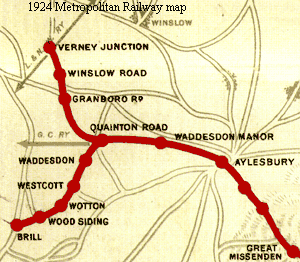 In 1894, the Met and GWR joint station at Aylesbury opened. Beyond Aylesbury to Verney Junction, the bridges were not strong enough for the Met's locomotives. The GWR refused to help, so locomotives were borrowed from the LNWR until two D class locomotives were bought. The line was upgraded, doubled and the stations rebuilt to main-line standards, allowing a through Baker Street to Verney Junction service from 1 January 1897 calling at a new station at Waddesdon Manor, a rebuilt Quainton Road, Granborough Road and Winslow Road. In 1894, the Met and GWR joint station at Aylesbury opened. Beyond Aylesbury to Verney Junction, the bridges were not strong enough for the Met's locomotives. The GWR refused to help, so locomotives were borrowed from the LNWR until two D class locomotives were bought. The line was upgraded, doubled and the stations rebuilt to main-line standards, allowing a through Baker Street to Verney Junction service from 1 January 1897 calling at a new station at Waddesdon Manor, a rebuilt Quainton Road, Granborough Road and Winslow Road.
The Manchester Sheffield & Lincolnshire Railway (renamed the Great Central in 1897) extended its main line south to meet the Metropolitan at Quainton Road and then ran alongside the latter to Finchley Road, where it diverged west to a separate terminus at Marylebone.
Around 1900 there was a train every two hours from Verney Junction, which stopped at all stations to Harrow, then Willesden Green and Baker Street. The timetable was arranged so that the fast train would leave Willesden Green just before a stopping service and arrived at Baker Street just behind the previous service.

Following a dispute between the two companies in 1902 administration of the line was transferred to a joint committee. From 2 April 1906 all Metropolitan services north of Harrow South Junction to Verney Junction were run by the Metropolitan and Great Central Joint Railway; this continued until 6 July 1936 when the London Passenger Transport Board, which had taken over the Metropolitan in 1933, withdrew local passenger services as an economy measure. Goods services were withdrawn at the same time.
 During 1939 work started on singling the line south of Winslow Road, with the double track left on a section from a pair of stops near the station to Verney Junction. The work was completed by 28 January 1940 and the line south of Winslow Road became effectively a long siding. Train crews operated the level crossing gates, and all signalling was removed to make the route one section between two junctions. Freight traffic from the Oxford to Bletchley line was rerouted via a connecting spur near Calvert which was brought into use on 14 September 1940, thereby allowing trains to work south over the Great Central main line. During 1939 work started on singling the line south of Winslow Road, with the double track left on a section from a pair of stops near the station to Verney Junction. The work was completed by 28 January 1940 and the line south of Winslow Road became effectively a long siding. Train crews operated the level crossing gates, and all signalling was removed to make the route one section between two junctions. Freight traffic from the Oxford to Bletchley line was rerouted via a connecting spur near Calvert which was brought into use on 14 September 1940, thereby allowing trains to work south over the Great Central main line.
After the war the Metropolitan service to Quainton Road was reinstated from May 1943,but the line between Quainton Road and Verney Junction remained closed to passenger traffic and through services ceased entirely on 7 September 1947, and the route closed. The reinstated Met service to Quainton Road was short-lived and in May 1948 it was cut back to Aylesbury,
After closure, the track was eventually lifted, although the northern section of the route between Verney Junction and Winslow Road was retained until 1957 for the storage of condemned rolling stock, with the track finally being removed in 1961.
Quainton Road Station is now home to Buckinghamshire
Railway Centre. Tickets Michael Stewart, Bradshaw from Chris Hind. See also: Abandoned Tube Stations web site - Aylesbury to Verney Junction. A History of the Metropolitan Railway Volume 3: From Aylesbury north to Verney Junction and Brill - Bill Simpson - Lamplight Publications, Oxon 2005 - ISBN 1 899 246 13 4
Sources:
See also:
Verney Junction, Granborough Road & Quainton Road |

road_old10.jpg)
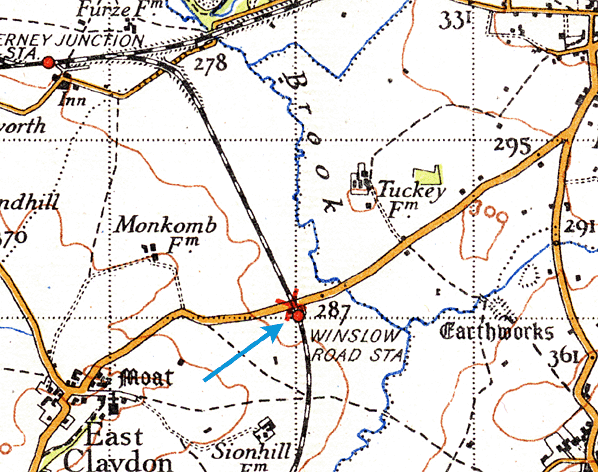
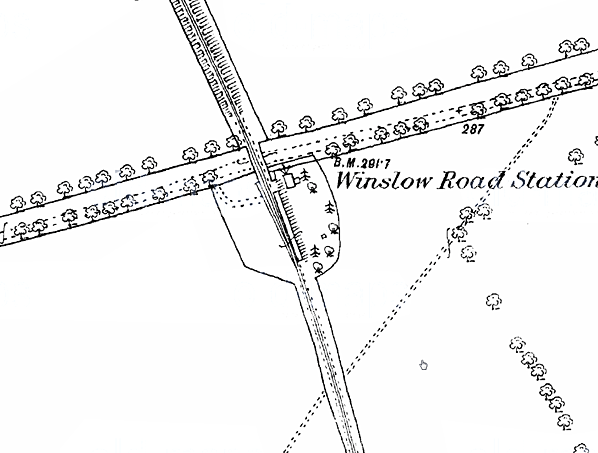
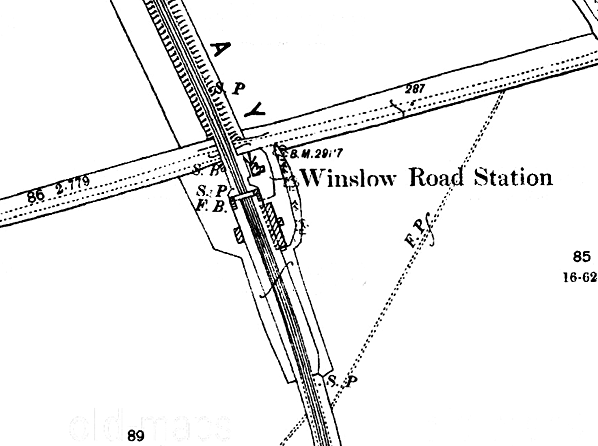
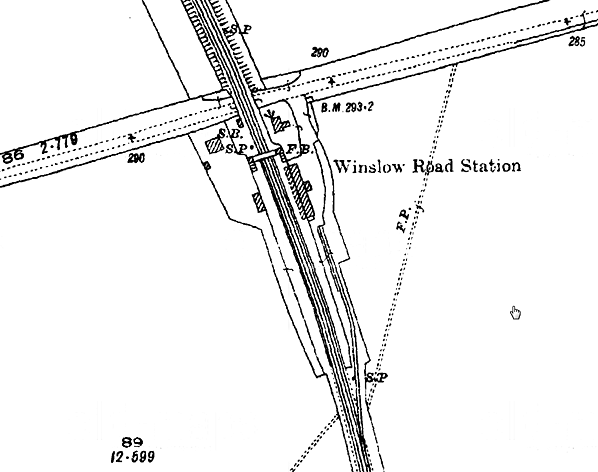
road_old8.jpg)
road_old4.jpg)
road_old13.jpg)
road_old3.jpg)
road_old2.jpg)
road_old7.jpg)
road_old5.jpg)
 Home Page
Home Page  When the Met took over the A&BR on 1 July 1891 the track was re-laid to main line standards and the station was entirely rebuilt with a longer platform. The line was doubled, and a down platform was also provided which partially obstructed the line of sight from the signal box. The new down line was on the site of the former siding. A single-storey rectangular brick building with a pitched slate roof was provided on the up platform. This included the booking hall, booking office, waiting rooms and toilets. The toilets were at the south end of the building with a ventilator on the roof. There was a short canopy over the entrance door in the centre of the building and, on the platform side, a flat-roofed canopy with a deeply fretted valance ran the full length of the building.
When the Met took over the A&BR on 1 July 1891 the track was re-laid to main line standards and the station was entirely rebuilt with a longer platform. The line was doubled, and a down platform was also provided which partially obstructed the line of sight from the signal box. The new down line was on the site of the former siding. A single-storey rectangular brick building with a pitched slate roof was provided on the up platform. This included the booking hall, booking office, waiting rooms and toilets. The toilets were at the south end of the building with a ventilator on the roof. There was a short canopy over the entrance door in the centre of the building and, on the platform side, a flat-roofed canopy with a deeply fretted valance ran the full length of the building. HISTORY OF THE AYLESBURY & BUCKINGHAM RAILWAY
HISTORY OF THE AYLESBURY & BUCKINGHAM RAILWAY
 Money was not found for this scheme, and the Met had to return to Parliament in 1880 and 1881 to obtain permission for a railway from Harrow to Aylesbury. Pinner was reached in 1885 and an hourly service from Rickmansworth and Northwood to Baker Street started on 1 September 1887. By then raising money was becoming very difficult although there was local support for a station at Chesham. Authorised in 1885, double track from Rickmansworth was laid for five miles, then single to Chesham. Services to Chesham calling at Chorley Wood and Chalfont Road started on 8 July 1889, and a temporary platform at Aylesbury opened on 1 September 1892 with trains calling at Amersham, Great Missenden, Wendover and Stoke Mandeville.
Money was not found for this scheme, and the Met had to return to Parliament in 1880 and 1881 to obtain permission for a railway from Harrow to Aylesbury. Pinner was reached in 1885 and an hourly service from Rickmansworth and Northwood to Baker Street started on 1 September 1887. By then raising money was becoming very difficult although there was local support for a station at Chesham. Authorised in 1885, double track from Rickmansworth was laid for five miles, then single to Chesham. Services to Chesham calling at Chorley Wood and Chalfont Road started on 8 July 1889, and a temporary platform at Aylesbury opened on 1 September 1892 with trains calling at Amersham, Great Missenden, Wendover and Stoke Mandeville. In 1894, the Met and GWR joint station at Aylesbury opened. Beyond Aylesbury to Verney Junction, the bridges were not strong enough for the Met's locomotives. The GWR refused to help, so locomotives were borrowed from the LNWR until two D class locomotives were bought. The line was upgraded, doubled and the stations rebuilt to main-line standards, allowing a through Baker Street to Verney Junction service from 1 January 1897 calling at a new station at Waddesdon Manor, a rebuilt Quainton Road, Granborough Road and Winslow Road.
In 1894, the Met and GWR joint station at Aylesbury opened. Beyond Aylesbury to Verney Junction, the bridges were not strong enough for the Met's locomotives. The GWR refused to help, so locomotives were borrowed from the LNWR until two D class locomotives were bought. The line was upgraded, doubled and the stations rebuilt to main-line standards, allowing a through Baker Street to Verney Junction service from 1 January 1897 calling at a new station at Waddesdon Manor, a rebuilt Quainton Road, Granborough Road and Winslow Road.
 During 1939 work started on singling the line south of Winslow Road, with the double track left on a section from a pair of stops near the station to Verney Junction. The work was completed by 28 January 1940 and the line south of Winslow Road became effectively a long siding. Train crews operated the level crossing gates, and all signalling was removed to make the route one section between two junctions. Freight traffic from the Oxford to Bletchley line was rerouted via a connecting spur near Calvert which was brought into use on 14 September 1940, thereby allowing trains to work south over the Great Central main line.
During 1939 work started on singling the line south of Winslow Road, with the double track left on a section from a pair of stops near the station to Verney Junction. The work was completed by 28 January 1940 and the line south of Winslow Road became effectively a long siding. Train crews operated the level crossing gates, and all signalling was removed to make the route one section between two junctions. Freight traffic from the Oxford to Bletchley line was rerouted via a connecting spur near Calvert which was brought into use on 14 September 1940, thereby allowing trains to work south over the Great Central main line. road_old11.jpg)
road_old9.jpg) The 6.20 pm service from Aylesbury to Verney Junction is seen in the down platform at Winslow Road station in March 1936 hauled by F78307. S.D. Holden designed these small 2-4-2T locomotives in 1909 for light passenger services. They were never a great success, and only twelve F7s were built at Stratford works. The F7s were used for lightweight branch line work in East Anglia. Although they were never very popular, the F7s were capable of hard work when required. At least one account exists of an F7 pulling a ten-coach train into Liverpool Street after the original locomotive had failed. Withdrawals started in 1931, but the last two survived just into Nationalisation and were withdrawn in November 1948. 8307 was withdrawn on 31 July 1943. None of the class has survived into preservation.
The 6.20 pm service from Aylesbury to Verney Junction is seen in the down platform at Winslow Road station in March 1936 hauled by F78307. S.D. Holden designed these small 2-4-2T locomotives in 1909 for light passenger services. They were never a great success, and only twelve F7s were built at Stratford works. The F7s were used for lightweight branch line work in East Anglia. Although they were never very popular, the F7s were capable of hard work when required. At least one account exists of an F7 pulling a ten-coach train into Liverpool Street after the original locomotive had failed. Withdrawals started in 1931, but the last two survived just into Nationalisation and were withdrawn in November 1948. 8307 was withdrawn on 31 July 1943. None of the class has survived into preservation.